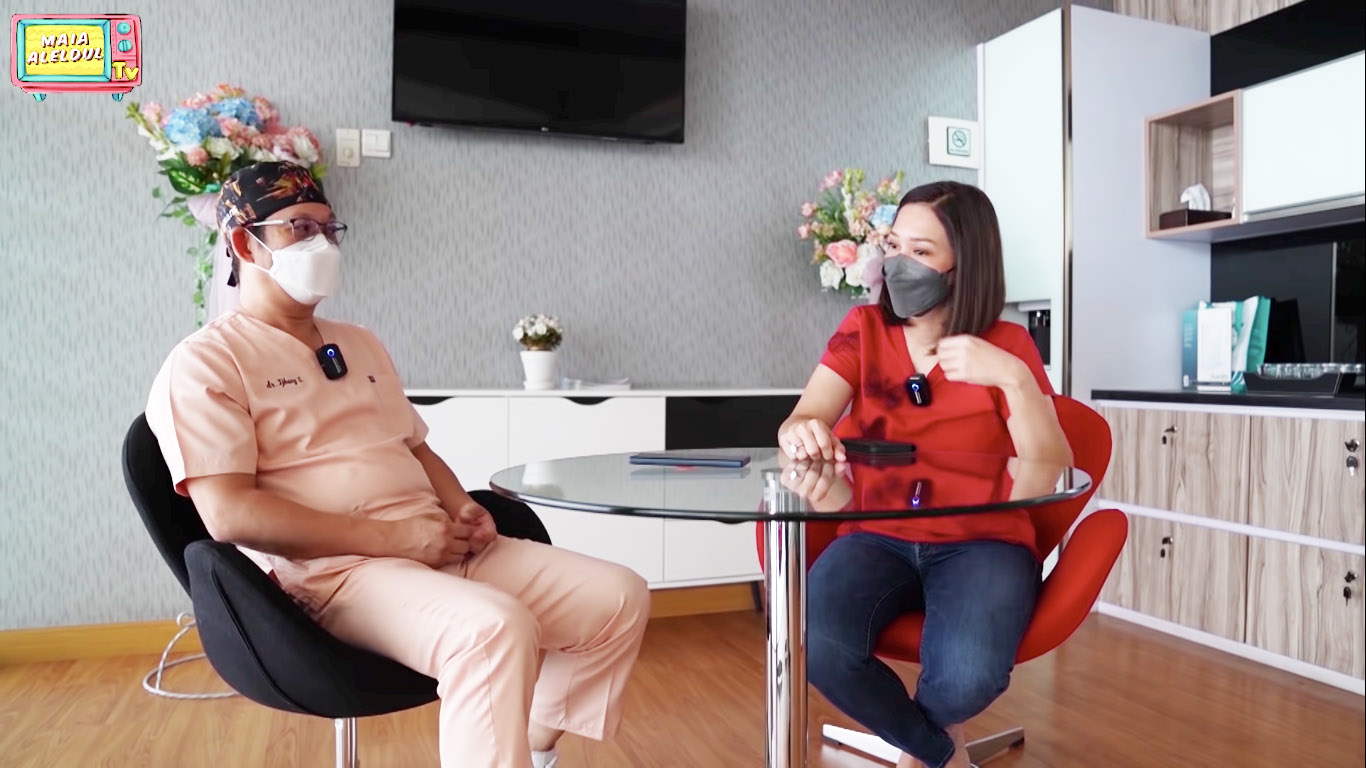
Recently there was an uproar in the media regarding Maia Estianty, who has GERD pain complaints. The disease that caused him a few days ago was taken to the hospital and received serious treatment.
On the Maia Aleldul TV Youtube Channel, the famous singer and music producer explains the GERD symptoms he is experiencing. According to Maia's story, she couldn't swallow because her throat hurt so much.
"At first, GERD was because I was taking medicine, then it felt like something was stuck in my esophagus. Then I drank water, but it still seemed like something stuck. In the end, it was my fault, I drank coffee because I'm a big coffee fan," said Maia in the YouTube video.
After drinking the coffee, Maia suddenly experienced pain when swallowing and drinking. It happened at Krisdayanti's birthday party.
The next day, Maia admitted that she had a fever and extreme pain. When explaining the pain, Maia pressed her stomach area in the solar plexus and admitted that it felt like razor blades. Immediately Maia sought help at the South Jakarta regional hospital accompanied by Dul, she explained that she had been given stomach acid pain relievers by injection.
"It was really comfortable, but the next day it hurt again to eat and drink. It felt like razor blades," he said. Due to this condition, Maia had to sleep in the living room because she had to sleep in an upright position.
Several days of treatment, her condition still did not improve until finally Maia was taken to the hospital with her favorite doctor who had also treated her several years ago regarding this condition. Maia was examined by dr. Tjhang Supardjo, M. Surg, FCCS, Sp.B, FCSI, FInaCS, FICS (Surgery Specialist for Liver, Gall, Spleen and Pancreatic Diseases at EMC Alam Sutera Hospital) and found gallstones in his body.

*Photo source: Youtube Channel Maia Aleldul TV
It was the gallstones that turned out to be causing Maia Estianty's GERD. "Because of this stone. The gallstones are large in size, they want to enter the duct, but because of their large size, they can't, they get stuck in the neck of the bile duct, that's what makes them sick," said Dr. Thjang when examining Maia Estianty's stomach contents.
"That's what makes Mother Maia feel sick to her stomach, so that GERD treatment everywhere won't heal, because the cause is gallstones. Take it (the stones), get it resolved. Only then will the GERD usually recover," added Dr. Thjang.
Apart from that, can gallstones really cause GERD?
In the case of Maia Estianty, gallstones that form in the body can cause GERD due to the location of the stones in the neck of the gallbladder. The effect of having these stones in the neck of the pouch which then causes GERD or a feeling of pain in the stomach and esophagus.
However, generally explained in the Gallstone Diet, when a person has gallstones in his bile, symptoms such as stomach pain can really occur. In addition, in some cases it also causes nausea and vomiting.
 *Photo source: Youtube Channel Maia Aleldul TV
*Photo source: Youtube Channel Maia Aleldul TV
Then, What's the Difference Between Gallstones and GERD Symptoms?
GERD ( gastroesophageal reflux disease ) or stomach acid disease is caused by a weakening of the valve or sphincter located at the bottom of the esophagus. Normally, this valve will open to allow food and drink to enter the stomach and be digested.
After food or drink enters the stomach, this valve will close tightly to prevent stomach contents from rising back up into the esophagus. However, in GERD sufferers, this valve is weakened, so it cannot close properly.
This results in stomach contents containing food and stomach acid rising into the esophagus. If this condition occurs continuously, the lining of the esophagus will become irritated until it becomes inflamed and over time it becomes weak.
Gallstone disease or cholelithiasis is a condition characterized by sudden abdominal pain due to the formation of stones in the gallbladder. Gallstone disease can also occur in the bile ducts.
The gallbladder is a small organ located under the liver. This organ is capable of producing and storing bile which plays an important role in digestive processes, including digesting cholesterol contained in the food consumed. Most gallstones come from cholesterol deposits which eventually harden and form stones.
GERD pain is characterized by a sensation of nausea and vomiting, no appetite, to heartburn. However, symptoms that you thought were simply due to GERD could be a sign of gallstone disease. What are the different symptoms of GERD and gallstones?
Different symptoms of GERD and gallstones
1. Different symptoms of heartburn
Heartburn is a common complaint, both as a symptom of GERD and gallstone disease. The reason is, these two things both occur in the digestive tract and are located next to each other in the upper stomach area.
GERD pain is caused by weakness of the lower esophageal muscles
to treat excess stomach acid production. The most common symptom of GERD is heartburn, namely the upper left abdomen accompanied by nausea and vomiting that tastes sour or bitter.
Gallstone disease also causes heartburn, but its location is more focused on the right upper abdominal area which radiates to the waist, back, and sometimes even to the shoulder.
Pain which is a symptom of gallstones also usually lasts a long time so it can last for hours. In addition, the pain does not improve after taking antacids or other ulcer medicines.
2. Different triggers for symptoms
Both of these health conditions can both occur after eating. However, the symptoms of gallstones usually get worse after eating fatty foods such as fried foods and coconut milk foods.
Whereas in GERD pain, any food, whether fatty or not, will still stimulate stomach acid production and cause pain.
Taking antibiotics, NSAID pain medications, and corticosteroids can also trigger GERD pain. However, the drugs mentioned do not affect the onset of gallstone symptoms.
3. Different accompanying symptoms
Have you been experiencing stomach pain lately and are wondering if the pain you are feeling is not GERD pain but gallstone pain? So don't get me wrong, people with gallstone disease will experience symptoms of sudden and intense pain in the right upper abdomen, pain under the breastbone, pain between the shoulder blades, pain in the right shoulder, and nausea and vomiting.
Unexplained chills or fever may indicate that you have an infection. In the gallbladder. If you have an infection, you need treatment before the condition worsens and complications. Because the infection can be life-threatening if it spreads to other parts of the body.
People with gallstone disease may experience chronic diarrhea. If you have more than four bowel movements per day for at least three months it may be a sign of chronic gallbladder disease.
Yellow skin, or jaundice, may be a sign of a blockage or stones in the common bile duct. The common bile duct is the duct that leads from the gallbladder to the small intestine. Also, lighter stools and dark urine are possible signs of bile duct obstruction.
Knowing the symptoms described above, it is clear that the condition of gallstone disease is more complex than GERD pain. Ordinary GERD pain will not make you experience jaundice or chronic diarrhea.
Gallstones are deposits of digestive juices that harden and form in the gallbladder. People who experience symptoms as mentioned above need gallbladder removal surgery.
How to Treat Gallstones?
Treatment of gallstone disease will be carried out based on indications of symptoms. Treatment options for gallstones include:
- Surgery to remove the gallbladder (cholecystectomy). Doctors may recommend surgery to remove the gallbladder when symptoms are intense enough. Once the gallbladder is removed, bile can flow directly from the liver into the small intestine and is no longer stored in the gallbladder.
You don't need a gallbladder to live, and removing the gallbladder doesn't affect your ability to digest food. It's just that this appointment can cause diarrhea, which is usually temporary.
- Medication to dissolve gallstones. Medicines you take can help dissolve gallstones. But it may take months or years of treatment to dissolve gallstones. Sometimes when drugs don't work, the only recourse is surgery.
You can reduce your risk of gallstones if you eat on time, are not obese, eat high-fiber foods, and exercise regularly.
For further information and consultation registration, please contact: 0811 1225 277 (Andy).
